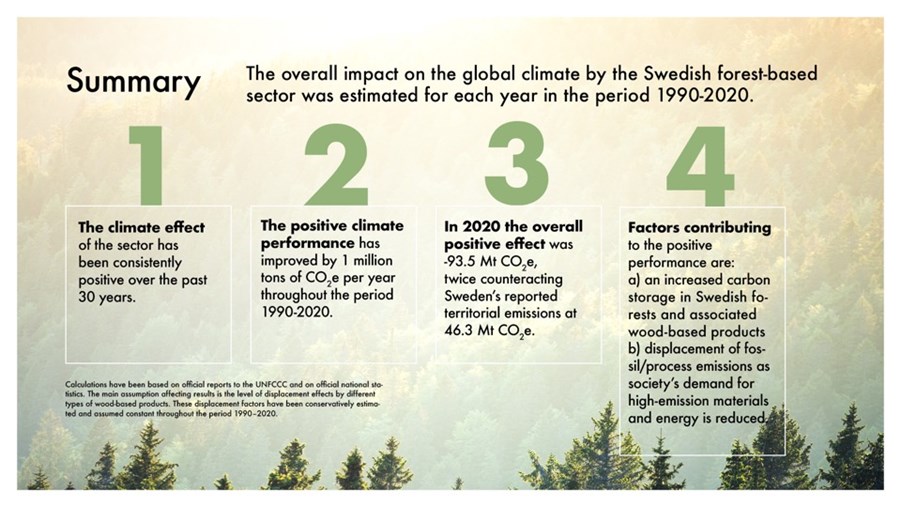
The climate benefit of the Swedish forest-based industry has increased by 46 percent over the past 30 years. This has made a strong contribution to reducing Sweden’s total carbon emissions, while also benefitting other European countries, where about 65 percent of all Swedish forest-based products are consumed. The Swedish Forest Industries’ new report, The Climate Impact by the Swedish Forest-based Sector 1990-2020, also shows that the industry annually creates a climate benefit that is twice as large as the entire country’s carbon emissions.
"Those are impressive numbers. During the last 30 years, the forest-based industry’s climate benefit has been considerable, while the conditions for biodiversity in the Swedish forests have consistently improved. Our industry is at the center of the green transition and I hope that will be acknowledged in the ongoing legislative work in Brussels", says Viveka Beckeman, Director General for the Swedish Forest Industries Federation (SFIF).
In a report from 2019, the SFIF conducted a pioneering study on the total climate effect by the Swedish forest-based sector, focusing on 2017, the year for which the latest data was available. Using the same methodology, the SFIF now broadens the scope to the last 30 years. Due to previous investments in sustainable forest management, the studied period has been characterized by a combination of increased standing timber volume in forests and more forest-based products on the market. Production of sawnwood has increased by 55 percent over the past 30 years, making up an increasing share of total production. Using wood in construction creates a double benefit: the carbon is stored for a long time while fossil-based alternatives are replaced. Due to increased productivity, the harvested area per year has basically not changed.
How does the forest-based sector benefit the climate?
The main drivers behind the positive contribution of the forest-based sector are the growing forests, that absorb and store carbon, and the forest-based products that both store carbon and replace fossil-based alternatives.
Also, the use of residual waste for bioenergy has greatly reduced dependence on oil and gas. Bioenergy accounts for more than 30 percent of all energy use in Sweden, which has made a strong contribution to reducing total climate emissions by 35 percent.
"The report shows that forest-based products are necessary to combat climate change. Nearly half of the climate benefit arises after harvest, by using fiber-based products and bioenergy instead of cement, plastic and oil. Renewable products and materials from forests ensure more oil, coal and natural gas stays in the ground", says Viveka Beckeman.
EU proposals risk limiting the climate benefit of forests
A number of legislative proposals have been presented by the European Commission as necessary steps to achieve the ambitious climate goals set within the framework of the Green Deal and the Fit for 55 package. Among the most relevant for the forest-based industry are the revision of the LULUCF (Land Use, Land Use Change and Forestry), the Renewable Energy Directive (RED III), the proposed Regulation on deforestation-free products and the recently adopted proposal for Ecodesign for Sustainable Products Regulation (ESPR).
"We clearly support the aim of these proposals. Driving the transition toward a fossil-free bioeconomy is one of our overarching goals as an industry. It is because of climate change that forest-based products are needed more than ever. The latest IPCC report shows that it may soon be too late to reach the climate goals set in the Paris Agreement, but also that active forestry is a part of the solution. Our new analysis confirms this clearly. Hopefully it will help EU-legislators make wise and informed decisions", concludes Viveka Beckeman.


